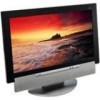Sharp IT23M1U Operation Manual - Page 16
Connecting the monitor to a computer
 |
View all Sharp IT23M1U manuals
Add to My Manuals
Save this manual to your list of manuals |
Page 16 highlights
Connecting the monitor to a computer CAUTION! - When connecting, ensure that the monitor and all the equipment you are connecting to it are switched off. - Be careful not to over bend the cable or add extension cords as this could lead to a malfunction. Analog connection Connect the supplied PC analog signal cable to the analog RGB output terminal of the computer. See page E8 for information on removing/ replacing the terminal cover. PC analog RGB input terminal Notes: - When using the monitor with an analog connection, perform an automatic screen adjustment (page E21) under the following conditions: - Using the monitor for the first time. - After having changed the system settings during use. - When using the monitor with a digital connection, automatic screen adjustment is unnecessary. - Depending on the computer or OS, you may have to install the set-up information for the monitor. (See page E37.) - When connecting to a notebook and the notebook computer's screen is set so that it is displaying at the same time, the MS-DOS screen may not be able to display properly. In this case, change the settings so that only the monitor is displaying. PC analog signal cable (supplied) Analog RGB output terminal - Paying attention to the connector direction, firmly insert the signal cable straight into the connector, and then tighten the screws at both ends. If connecting to a D-sub 15 pin 2 row Apple Power Macintosh, attach a Macintosh conversion adapter (commercially available) to the analog signal cable. Power Macintosh Macintosh conversion adapter IT-23M1U_gb_01.P65 14 E14 2004/08/20, 10:41















